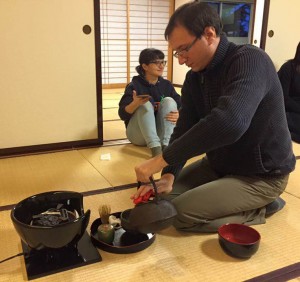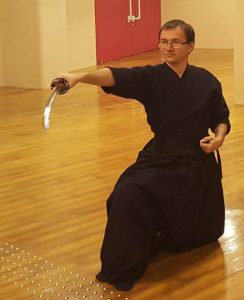AIU TOPICS
AIU Voices
Student Voice: Dan Serbanica, University of Bucharest, Romania
Extracurricular Activities: Clubs
Participating in clubs is especially important for students like me who are taking all Japanese language classes. Of course, there are no Japanese students in my classes, so clubs are my only chance to interact with the local students.
I am very interested in Japanese culture, so I joined both the Tea Ceremony Club and Iaido Club. Iaido is a martial art that focuses on the motion of drawing the sword, but it actually has a lot in common with Tea Ceremony.
Tea Ceremony
I took the Tea Ceremony (Sado) class during the fall semester, and I wanted to learn and practice more, so I joined the club, as well.
I find the tea ceremony very relaxing and enjoyable, especially when we are participating with just our friends from the club. You have to focus on the movements and clear your head of other distractions, so it’s like meditation. If you are particularly stressed about classes or day-to-day life, tea ceremony helps you deal with it and become more patient.
In more formal settings there is more pressure, but perhaps once you get better at it, that goes away. I had the chance to participate in a New Year celebration Tea Ceremony with our sensei and her friends. It lasted nearly two hours, and even though I am taking Higher Intermediate Japanese, it was hard to follow some of their formal speech and Akita dialect, so another student helped interpret for me. The ceremony was an interesting and unique look at the local culture.
I’ve seen there are some misconceptions about Tea Ceremony, too, like some student believe that it is only for women. Actually, in the formal practice, only men are allowed to hold the master ranks, and they are typically given the position of honor in the ceremony, even if there are fewer of them. Our club and class are mostly women, but I would recommend more men to join, as well!
Iaido
It is strange to compare tea with swords, but I have found several similarities in the practice.
For example, in Iaido, there is no opponent. Just like in the tea ceremony, you have to focus entirely on your own movements and perfect yourself. Also, the motion of drawing the sword is similar to the motion we make in tea ceremony to draw the silk cloth from our belts to clean the implements. The way we sit seza is also the same between both tea ceremony and iaido, although it is different from other martial arts.
Extracurricular Activities: Clubs
Participating in clubs is especially important for students like me who are taking all Japanese language classes. Of course, there are no Japanese students in my classes, so clubs are my only chance to interact with the local students.
I am very interested in Japanese culture, so I joined both the Tea Ceremony Club and Iaido Club. Iaido is a martial art that focuses on the motion of drawing the sword, but it actually has a lot in common with Tea Ceremony.
Tea Ceremony
I took the Tea Ceremony (Sado) class during the fall semester, and I wanted to learn and practice more, so I joined the club, as well.
I find the tea ceremony very relaxing and enjoyable, especially when we are participating with just our friends from the club. You have to focus on the movements and clear your head of other distractions, so it’s like meditation. If you are particularly stressed about classes or day-to-day life, tea ceremony helps you deal with it and become more patient.
In more formal settings there is more pressure, but perhaps once you get better at it, that goes away. I had the chance to participate in a New Year celebration Tea Ceremony with our sensei and her friends. It lasted nearly two hours, and even though I am taking Higher Intermediate Japanese, it was hard to follow some of their formal speech and Akita dialect, so another student helped interpret for me. The ceremony was an interesting and unique look at the local culture.
I’ve seen there are some misconceptions about Tea Ceremony, too, like some student believe that it is only for women. Actually, in the formal practice, only men are allowed to hold the master ranks, and they are typically given the position of honor in the ceremony, even if there are fewer of them. Our club and class are mostly women, but I would recommend more men to join, as well!
Iaido
It is strange to compare tea with swords, but I have found several similarities in the practice.
For example, in Iaido, there is no opponent. Just like in the tea ceremony, you have to focus entirely on your own movements and perfect yourself. Also, the motion of drawing the sword is similar to the motion we make in tea ceremony to draw the silk cloth from our belts to clean the implements. The way we sit seza is also the same between both tea ceremony and iaido, although it is different from other martial arts.


